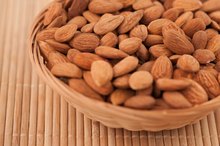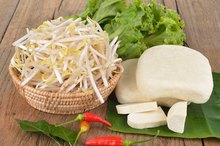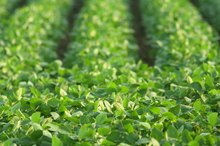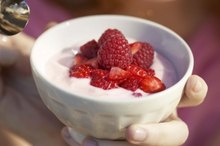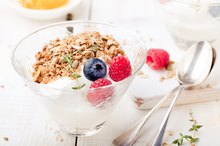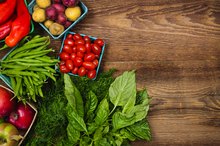Candida, a yeast-like fungus, lives in every person’s body and normally does not cause any issues. Sometimes it can grow unchecked and excess can build up in areas like the vagina, intestines and mouth. Some health care practitioners believe excess yeast contributes to a wide range of health problems including body odor. This remains a matter of debate in the medical community, but if you believe excess candida might be contributing to body odor, certain dietary changes can reduce yeast growth.
If you are experiencing serious medical symptoms, seek emergency treatment immediately.
Link Between Yeast and Body Odor
Edward F. Group, chiropractor, herbalist and certified clinical nutritionist, explains that systemic yeast infections cause yeast to convert sugar into alcohols that can contribute to body odor. Additionally, yeast typically overgrows when the intestine does not contain enough of the friendly bacteria that prevent yeast and other substances from growing out of control. According to Group, testing has shown people who suffer from body odor tend to have lower levels of these beneficial bacteria.
Cutting Back on Refined Sugars
Candida Diet & Almonds
Learn More
According to chiropractor and integrative medicine specialist Rodger Murphree, candida feeds on sugar 1. He recommends cutting out all forms of added sugars as best you can for three months to eradicate excess intestinal yeast. This means avoiding any processed food that lists sugar as an ingredient 1. He also suggests avoiding milk products, which contain the milk sugar lactose, fruit juice and dried fruit. Yogurt is one exception because it contains the friendly bacteria necessary to combat yeast. Once the three months has passed, you should do your best to limit your intake of sugar.
- According to chiropractor and integrative medicine specialist Rodger Murphree, candida feeds on sugar 1.
- Yogurt is one exception because it contains the friendly bacteria necessary to combat yeast.
Other Carbohydrate Considerations
Cynthia Perkins, a nutritional counselor, also cautions against eating foods high in carbohydrates in large amounts. She recommends eating the grains quinoa, amaranth and kamut. Fruits contain sugar as well in the form of fructose, and Perkins recommends sticking to lower-fruit sugars such as pears and berries of all kinds.
Permitted Items
Yeast Infections & Vitamins
Learn More
When eating to reduce candida growth, you should focus on lean proteins and low-carbohydrate vegetables 1. Acceptable proteins include meats and fish of all kinds but avoid processed versions like cold cuts 1. Low-carbohydrate vegetables include:
- broccoli
- cauliflower
- cabbage
- spinach
- peppers
- onions
- garlic
- lettuce
- cucumbers
- zucchini
- avocados
- tomatoes
Murphree says you can eat nuts and seeds, but only in small amounts
Probiotic Supplementation
Probiotic supplements can help replenish your supply of good bacteria 1. Group recommends supplementing with products that contain the strains lactobacillus acidolphilus or bifidobacterium.
Related Articles
References
- No Hype Holistic Health Solutions: Candida Diet
- Yapar Nur. Epidemiology and risk factors for invasive candidiasis. Ther Clin Risk Mgmt. 2014;10(2014):95-105. doi:10.2147/tcrm.s40160
- Buggio L, Somigliana E, Borghi A, Vercellini P. Probiotics and vaginal microecology: fact or fancy? BMC Womens Health. 2019 Jan;19:25. doi:10.1186/s12905-019-0723-4
- Gunther LSA, Martins HPR, Pimenta de Abreu AL, et al. Prevalence of Candida albicans and non-albicans isolates from vaginal secretions: comparative evaluation of colonization, vaginal candidiasis and recurrent vaginal candidiasis in diabetic and non-diabetic women. Sao Paulo Med. J. 2014;132(2):116-20. doi:10.1590/1516-3180.2014.1322640
- Xie HY, Feng D, Wei DM, Mei L, Chen H, Wang X, Fang F. Probiotics for vulvovaginal candidiasis in non-pregnant women. Cochrane Database Syst Rev. 2017;23;11(11):CD010496. doi:10.1002/14651858.CD010496.pub2
- Niewenhuizen WF, Pieters RHH, Knippels LMJ. Is Candida albicans a trigger in the onset of coeliac disease? Lancet. 2003;361(9375):2152-4. doi:10.1016/S0140-6736(03)13695-1
- Pérez-Torrado R, Querol A. Opportunistic strains of Saccharomyces cerevisiae: A potential risk sold in food products. Frontiers Microbiol. 2016;6:8. doi:10.3389/fmicb.2015.01522
- Wilson D. A tale of two yeasts: Saccharomyces cerevisiae as a therapeutic against candidiasis. Virulence. 2017;8(1):15-7. doi:10.1080/21505594.2016.1230580
- Office of Disease Prevention and Health Promotion. (2015) Appendix 7. Nutritional Goals for Age-Sex Groups Based on Dietary Reference Intakes and Dietary Guidelines Recommendations. 2015-2020 Dietary Guidelines for Americans. Washington, D.C.: U.S. Department of Health and Human Services.
- Kim J, Sudbery P. Candida albicans, a major human fungal pathogen. J Microbiol. 2011;49(2):171-7. doi:10.1007/s12275-011-1064-7
- Martinez RCR, Franceschini SA, Patta MC, et al. Improved treatment of vulvovaginal candidiasis with fluconazole plus probiotic Lactobacillus rhamnosus GR-1 and Lactobacillus reuteri RC-14. Letters Applied Microbiol. 2009;48(3):269-74. doi:10.1111/j.1472-765x.2008.02477.x
Writer Bio
Kelli Cooper has been a writer since 2009, specializing in health and fitness. She holds a Bachelor of Arts in political science from Rutgers University and is a certified personal trainer with the American Council on Exercise.
